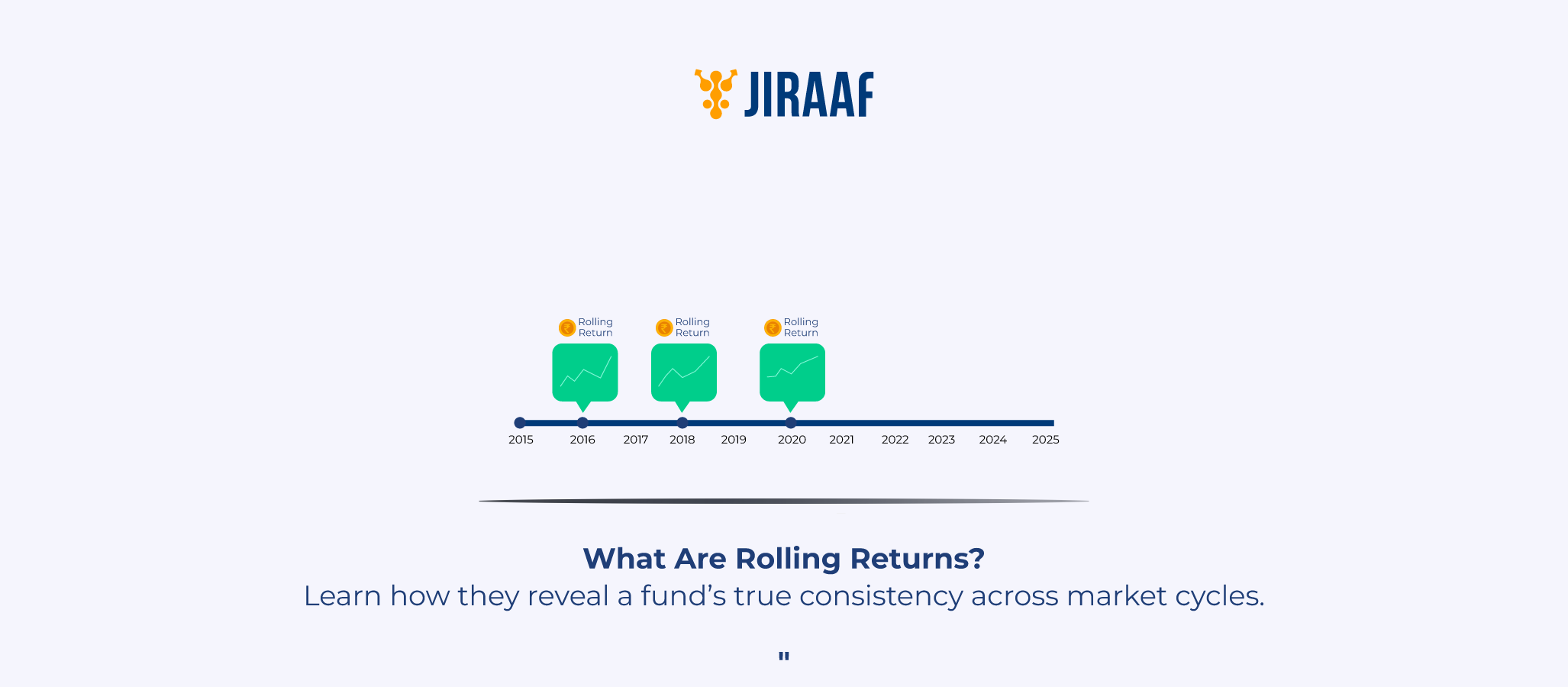Looking at rolling returns is an essential factor while evaluating the returns of mutual fund investments. It provides a thorough summary of a fund’s performance over time, thus giving you a deeper understanding of its past returns and how it performs. To make wise investment decisions, you must understand the idea of rolling returns, how they work, and the efficient techniques for assessing and interpreting these returns.
What is Rolling Return in Mutual Funds?
A rolling return, sometimes called a rolling period return, looks at how the mutual fund performs over several overlapping periods as opposed to predetermined, set periods. Using this, you can measure a mutual fund’s average annual return across several overlapping periods, which provides a comprehensive picture of the fund’s performance over time. With this method, you can also track the fund’s steady performance over time, providing information about its volatility and dependability in different market conditions.
How Rolling Returns Are Calculated: Formula & Example
Rolling returns are calculated by choosing a period (for example, one, three, or five years) and continuously assessing the fund’s performance during that period. To examine a fund’s 5-year return over ten years, for instance, you would compute the 5-year return for every day of that period. Accordingly, you will be evaluating the returns on January 1, 2010, and compute it for each day after that until December 31, 2020. Let’s understand this better with an example.
Assume you’re evaluating a mutual fund’s 5-year rolling returns from 2002 to 2006 to determine its consistency. Here’s how it works in practice:
Step 1: Define the period
Let’s start with 2002–2006 or a period of five years. Suppose the fund’s annual returns were:
2002: 17%
2003: 10%
2004: 14%
2005: 5%
2006: 8%
Step 2: Calculate average returns
(17 + 10 + 14 + 5 + 8) / 5
= 54 / 5
= 10.8%
This is your first 5-year rolling return (2002–2006).
Step 3: ”Roll” the window forward
Now, drop 2002’s return (17%) and add 2007’s return (assume 12%).
New returns: 10 + 14 + 5 + 8 + 12 = 49%.
New average: 49/5 = 9.8% (2003–2007).
Step 4: Repeat for all periods
Continue this process year after year (For example, 2004-2008, 2005-2009, 2006-2010 and so on) to see how returns can change over time.
Why Rolling Returns Offer a More Accurate Picture Than CAGR
Rolling returns, unlike the compound annual growth rate (CAGR), present a more lively and realistic view of how the investment would have performed if you had invested on a certain day, whereas CAGR calculates returns based on the investment’s original and final values over time, without accounting for variations. While CAGR measures your returns over a given period, rolling returns indicate returns across overlapping periods – one, three, or five years – on a rolling basis, including any changes over time.
Advantages of Using Rolling Returns to Evaluate Funds
Rolling return is an important tool for assessing mutual funds since it provides several significant advantages, such as:
- Measuring consistency: By studying rolling returns, you can discover funds that have consistently produced decent returns over a certain time period. This information helps in making well-informed and smart investment decisions.
- Comparing performance: You can use rolling returns to compare how many different mutual funds perform over different periods or in different situations. This can help you determine the fund that best fits your investment goals.
- Evaluating risks: Analyzing rolling returns can also help you measure the mutual funds’ risk-adjusted performance. This technique helps you understand the risk associated with each mutual fund, allowing you to align your investments with your risk tolerance.
- Smart period selection: You can select among numerous intervals, three years, five years, or ten years, to sight the highest, lowest, and average returns accumulated by a fund throughout that period.
When to Use Rolling Returns for Investment Decisions?
You can consider using rolling returns while evaluating your investment decisions in many cases, such as:
- Mutual Funds and ETFs: Rolling returns can help you analyze the consistency of a fund manager’s performance when it comes to mutual funds and ETFs. They can also help you compare how different funds perform and make better investment decisions.
- Bond Investments: Rolling returns can help you in estimating the interest rate and credit risk of bonds and bond ETFs. They can also portray how changes in interest rates affect your investment returns over time.
- Real Estate Investments: Rolling returns can be used to evaluate the performance of real estate investments, considering rental income, property value, and the market conditions. This can help you make more educated decisions about whether to buy, sell, or hold real estate assets.
- Equity Investments: You can use rolling returns to compare the performance of individual stocks or equity funds over a period of time. This can give you more information about your investment’s risk and return characteristics, as well as the consistency of its performance.
Conclusion
Analyzing rolling returns can help you look beyond just average returns and examine the dispersion of returns across time. This method also allows you to understand the uniformity of a fund’s performance, demonstrating whether it produces stable returns or has substantial fluctuations in its performance. For example, two funds can have identical average rolling returns, but one may be steadier, and the other may have noteworthy variations. Furthermore, this provides a more accurate picture of how the fund works during both, market booms and slumps. This approach allows you to select funds that match your risk tolerance and investing objectives by finding solutions with more consistent returns over time.
FAQs
What is rolling return in mutual funds and why is it important?
Rolling returns provide a more uniform evaluation of mutual fund performance by analyzing returns over many timeframes and removing biases from specific periods. This strategy displays a fund’s consistency, makes it easier to compare funds, and helps estimate risk by recognizing performance trends.
How are rolling returns different from CAGR?
CAGR measures an investment’s average yearly growth over a certain period, assuming that growth occurs at a constant rate. Rolling returns, on the other hand, evaluate a fund’s annualized returns over a specific time period, such as every 12 or 36 months, allowing greater flexibility and insights into performance.
Can rolling returns help in SIP performance evaluation?
Yes, rolling returns are an excellent tool for analyzing SIP performance. Unlike point-to-point returns, rolling returns examine all conceivable investment periods within a timeframe (ex, three, five, or ten years) to determine consistency.
Is rolling return a reliable metric for long-term investing?
Mutual fund rolling returns can show consistency and dependability, which is very helpful for long-term investors. You can steer clear of the drawbacks of fixed-time computations, like annual returns, which might only offer a limited perspective of fund performance, by looking at several time periods.
Discover fixed income investments with Jiraaf, a SEBI registered online bonds platform that educates and brings access to a wide array of bonds. Sign up today to explore diversified fixed income investment opportunities to support your goal-based wealth creation journey. Start investing!









